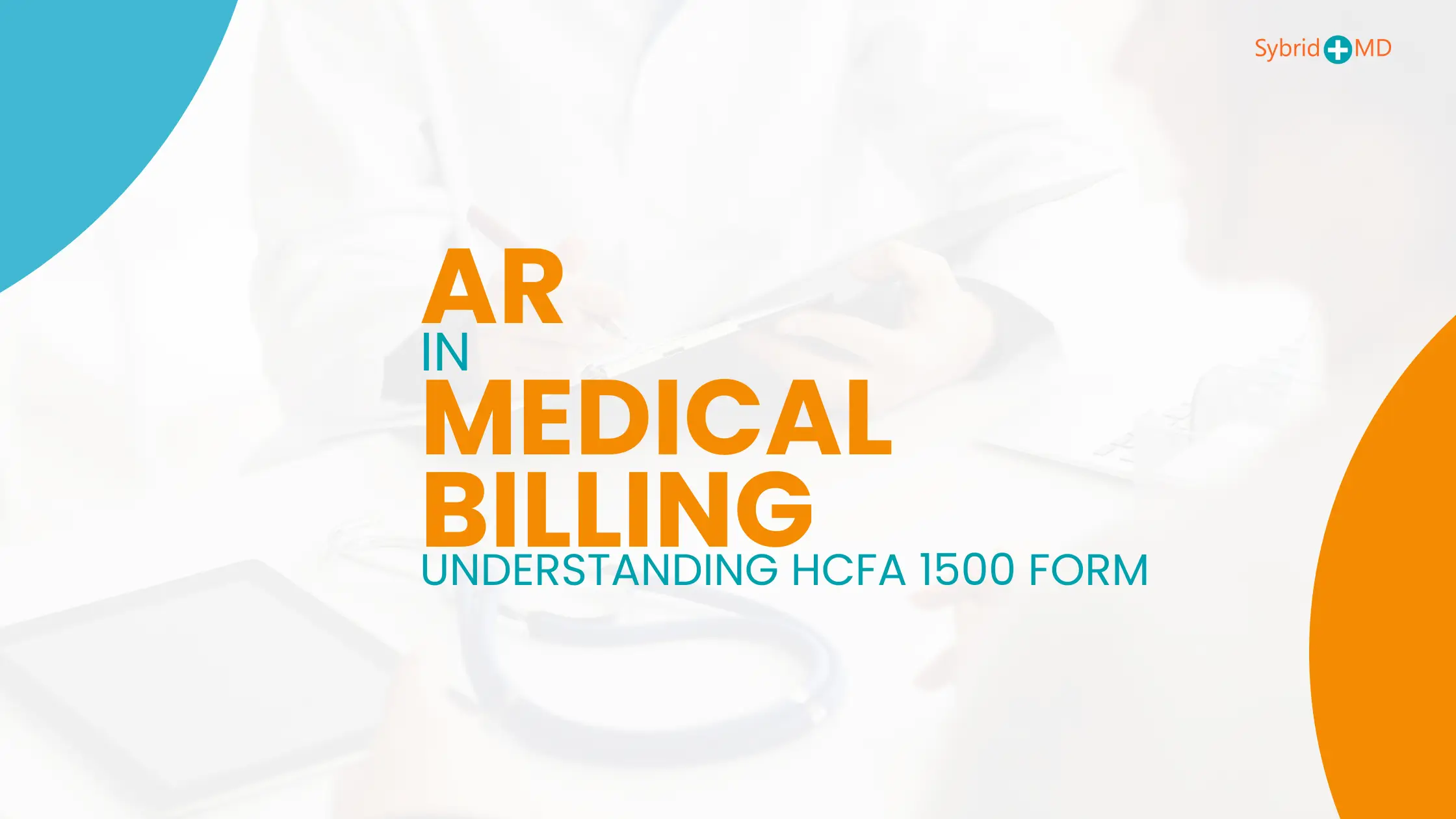Healthcare providers perform services and use insurance or health cards to ensure that they are paid for these services. So, What is AR in the Medical Billing? Accounts Receivables (AR) is one of the key components of healthcare billing. If you are in the field of healthcare management, or medical billing you need to agree with me that the nitty-gritty of AR in medical billing is essential to the smooth running of your practice or a healthcare facility. We will also explain what we mean by AR in medical billing, where AR follow up in medical billing fits in with this picture, and how this connects with broader concepts such as the HCFA 1500 form.
What is AR in Medical Billing?
In medical billing AR stands for accounts receivable that refers to the due payments owed by healthcare providers (Doctors, Hospitals, or clinics) to a patient, insurance companies, or government programs. The unbalanced payment is logged under Accounts Receivable. At the hospital level, AR is all the services rendered for which the corporation has yet to be paid. And with this being strongly tied to the financial viability of health organizations, finding ways to manage these payments efficiently is all about success.
The accounts receivable AR process begins after a patient receives treatment and ends with the collection of the bill from the patient and/or an insurance provider. If managed properly, AR may still turn out to be a key element of seamless cash flow and business continuity.
AR Follow Up In Medical Billing: Its Significance
The approval process of a medical claim can take time and sometimes it gets rejected by either the insurance company or the patient. And this is where (my addition) follows up on the medical billing AR category, as medical billing follows up with the insurance or patients to receive any outstanding balances on unpaid claims.
AR Follow-Up Includes:
- Active Claims Reviews: You search for claims that have not been paid yet (usually within 30 to 60 days);
- Why a claim was not covered: Reason not paid. This can happen because of bureaucratic screwups, missed deadlines, or bad data.
- Alerting Insurers or Patients: Picking up the phone and asking why a payment hasn’t come through — and resolving any issues with a claim submission.
- Denial Resolution: If an insurance claim is denied, AR follow-up can also be the process of appealing or correcting errors so that the claim is paid as expected, or adding supplemental documentation.
A proper AR follow-up process guarantees reimbursement for the services of a healthcare provider, resulting in a good revenue cycle and the prevention of unnecessary financial strain.
Assimilating the Role of HCFA 1500 in Medical Billing
In medical billing, the HCFA 1500 form or the CMS-1500 form is one of the important forms. It is used by health care providers to charge for reimbursement from insurers both government programs like Medicare and Medicaid and from private payers.
HCFA 1500 (Health insurance claim form), this is used to bill to the private insurance companies or the government. Like patients’ and providers’ demographics, the services, diagnostic codes and the following fees of the services. It might also include some additional information for reference like CPT (Current Procedural Terminology) codes (procedure or service rendered by a medical professional) and ICD (International Classification of Diseases) codes (diagnosis of patient).
When the medical service is provided, the claim form is submitted to the insurance company as a notification to the company to reimburse for the service, so it is critical that the payment of service is made timely and accurately. Completing the CMS-1500 form accurately is also a preventive measure against claim denial and delayed payments. Mistakes or a failure to provide adequate paperwork can delay processing, which directly affects a healthcare provider’s cash flow.
What Is HCFA 1500? What does the HCFA 1500 stand for?
The above discussion answer the question that What is the HCFA 1500? An HCFA 1500 claim form is a standard paper form that many health care providers use to bill patients and/or their insurance carriers. This provides more detailed information about the patient, the services performed and related costs. This form is used to ensure health care providers are paid what they are owed.
What all some information the HCFA 1500 form captures?
- Patient Information: Name, address and insurance details.
- Provider Information: The name, address and identification numbers of the health care provider.
- Services Rendered: The type of procedures, treatments, or consultations the patient received.
- Diagnosis Codes: ICD (International Classification of Diseases) codes to denote to the patient’s condition.
- CPT (Current Procedural Terminology) Codes: Codes that describe what was done.
- Charge Information: The total charges billed to the insurance company for each of the services provided.
Is HCFA the Same as CMS?
Can we question Is HCFA identical to CMS? It will turn out that HCFA, (Health Care Financing Administration) is an alternate name for the U.S.-based government agency that manages the Medicare and Medicaid programs. But in 2001 HCFA was altered and its new name was CMS (Centers for Medicare and Medicaid Services). While the name is new, the function and role of the agency managing federal healthcare programs remains the same.
So to answer your question: HCFA and CMS are two names for the same agency, although CMS is the current official name. CMS had also previously tried to streamline the agency’s role in overseeing health care services.
What is the HCFA also Known as?
The HCFA 1500 form use most often by the healthcare industry for medical billing and insurance claims submissions. Officially it is now referred to as the CMS-1500 form, though in conversation between professionals about the form, you may still hear it referred to as the HCFA 1500 form due its historic use. (HCFA) — the predecessor agency now known as the Centers for Medicare & Medicaid Services (CMS) — first developed this form. And so HCFA stuck, despite the agency being renamed CMS in 2001.
The CMS-1500 form has one main purpose, which is enabling health care providers to bill private insurers and government programs like Medicare and Medicaid. Key information such as patient demographics, medical diagnosis information, and services rendered are included, including procedure codes (CPT/HCPCS) and charges. Being a major component of the medical billing process, clinical coding helps ensure payment for services rendered, and continues to be a key tool in the preparation of accurate and timely insurance claims.
Managing AR in Healthcare
There are various important steps to be taken when ensuring efficient AR management in healthcare. Here are some efficient ways of dealing with AR:

Submitting Claims in Time: It is important that all the medical claims are submitted with the insurance firms as soon as possible. The sooner a claim is filed, the sooner a payment can be processed.
Code Properly: Make sure you are using the right medical codes (ICD, CPT, and HCPCS); else your claims will be denied. One of the more common reasons for delays in payment is coding errors.
Systematic Follow-ups: You need to follow up after you create an AR follow-up system to monitor your unpaid claims. If the claim is denied, or left unpaid, healthcare providers must assign staff to continually inquire about it with the insurance company or with the patient.
Establish Effective Communication: Communication is the key. It prevents potential issues from being obstacles to payment.
Denial Management: Devise a standard method to carry out denial management this means asking the why behind the denial, contesting the appeals if it happens to be wrongfully denied and adding extra documentation when required.
Patient Collections: So if you did more than simply sit on the phone with insurance carriers, you’ll eventually need a method for collecting payment directly from the patient. That could mean establishing payment plans or collecting co-pays at the door.
Outsource AR process: Certain healthcare organizations outsource their AR work to third-party agencies that have established expertise in billing and collections. This makes it easier and even helps cash flow
Top Issues in the Management of AR
Managing Accounts Receivable (AR) plays a vital role in the financial sustainability of a healthcare practice in the medical billing industry. Some of the healthcare providers face multiple challenges which directly impact their revenue cycle. Insurance complications are one of the major issues at play. Avoiding administrative challenges and delays.
- Most doctors lack adequate knowledge of how to deal with insurance networks, payer regulations or reimbursement rates that can delay or deny claims. These insurance arrangements are complex and require careful management.
- Another very big challenge is billing mistakes. Simple errors, from filing the wrong patient name to making coding errors, can mean claims are denied or payments delayed.
- Providers must also keep pace with the changing landscape of healthcare billing — laws, codes and payer rules that are updated so frequently that they’re nearly a daily occurrence.
- Patient Payment Delinquent. Patients who have treatment and struggle, or are unwilling to, pay their medical bills may need payment arrangements or financial assistance programs to settle these debts.
- Insufficient funds and time also can demoralize the AR management. And most healthcare practices don’t have the staff nor the processes to chase these 90-day overdue payments that can create massive cash flow problems.
Healthcare organizations need to understand AR follow-up so that they can maintain a positive revenue cycle. This involves keeping an eye on unpaid bills and ensuring that healthcare providers are paid for their services. One important component of the process is the HCFA 1500 form, which must be accurately filled out for the claim to be successful. AR Management software makes it easier to make payment collection process smoother otherwise it gets challenging to keep a check on cash flows.

